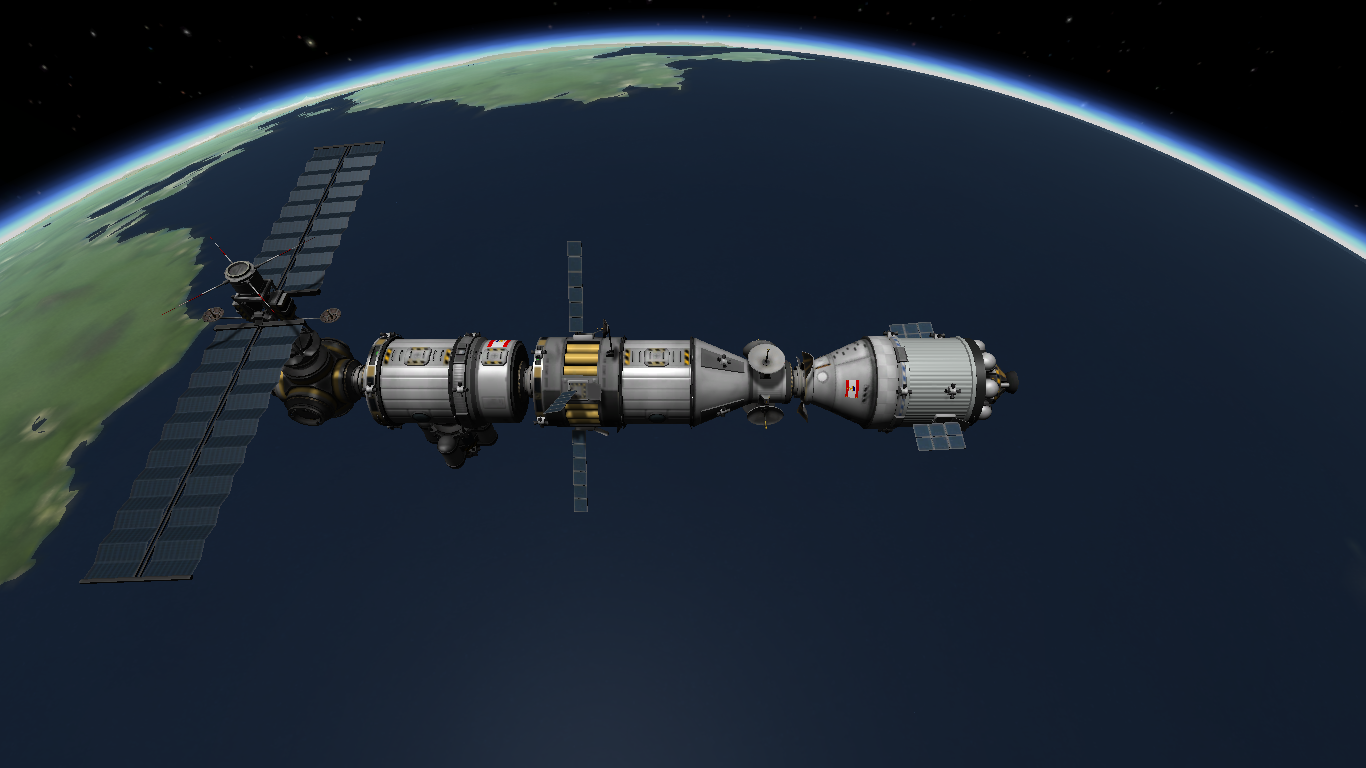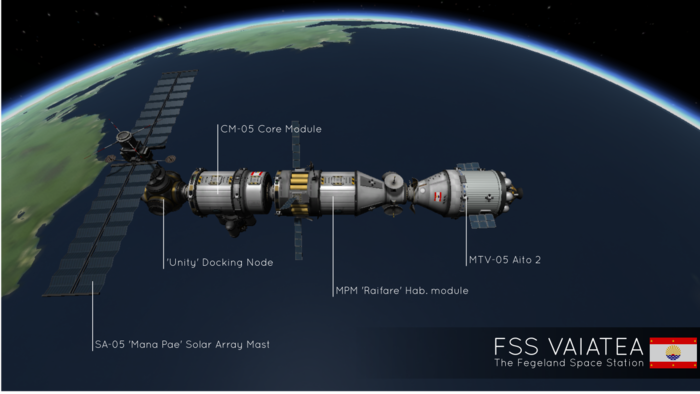FSS Vaiatea
|
FSS Vaiatea
FSS-01 'Vaiatea' / IAU: EF-FA-FSS-01A
|
|||||
|---|---|---|---|---|---|
| Space Station | |||||
 |
|||||
| The FSS Vaiatea, as of 2074 | |||||
| National Origin | Fegeland | ||||
| Production History | |||||
| Designed | |||||
| 2056 - 2069 | |||||
| Designer | FAITO Aerospace | ||||
| Service History | |||||
| In Service | |||||
| 2058 - Today | |||||
| Used By | Fegeland | ||||
| Spacecraft Characteristics | |||||
| Launch Mass | [full mass] kg | ||||
| Dry Mass | [empty mass] kg | ||||
| Length | [length] m | ||||
| Width | [deck width] m | ||||
| Height | [height] m | ||||
| Propulsion | Assured by docked vessels | ||||
| Complement | 4 kerbals by rolls of 3 months | ||||
| Regime | Low Kerbin orbit | ||||
| Armament | 1x Patator, 1x surfboard | ||||
| Surfboards Carried | 1 | ||||
The Feguan Space Station 1, FSS Vaiatea, is a space station launched by FAITO Aerospace and operated by the Empire of Fegeland. The first module was launched in 2058 and the station assembly and utilization gradually stalled after 2070, although it remained in reduced service to this date, as the longest continuously-operated space station. Since 2075, the station is made of 4 different modules, plus a MTV-05B 'Aito 2' vessel permanently docked on the station in case of emergency.
Composition and building
The station is built using a modular architecture. Several modules are launched separately then docked together in space. There are currently 4 main modules on the station, plus two separate ships :
- The Core Module, first one to be launched. It have 4 solar panels, storage capabilities, and an attitude control system.
- The Multipurpose Habitation Module. This module serves as an habitation for the crew of 4. It can also be used to conduct scientific experiments. Two docking ports and high-range antennae are also available.
- The Docking Node DN2 Unity, which provides 6 additional docking ports for adding modules. Two of the 6 ports are currently occupied, one for docking the node on the core module, the other for the solar array mast.
- The Solar Array Mast SA-05 'Mana Pae', which provides electrical power to the station.
Two spacecraft are also permanently docked on the station, and thus can be considered as part of it.
- A UTV-03 'Vini iti' tug, used for grabbing and placing new modules on the station
- A MTV-05B 'Aito 2' vessel, used for transferring the first crew members on the station. As a safety feature, it remained attached to the station. This ensure there's always a way to escape it in case of an accident.
All those modules were launched by either the STS-01 'Bora-Bora' Space Shuttle or by FRS-09C Falcon 9 launchers. Supplying of the station is provided by the MTV-07 Dragon A spacecraft, the successor of the Aito 2 for LKO missions.
History and future evolutions
The idea of a space station was born early in the Feguan space history. But the first serious thoughts about it date from 2056, when the Falcon 9 launcher became operational in it's small version (FRS-09A).
Fegeland space engineers wanted to have something to launch in order to test their new launcher, before sending manned missions. At the same time, other development teams were working on a space shuttle project. The STS-01 Bora-Bora space shuttle development ended a few months after the station's modules assembly. That's why half of them were launched by the STS-01 instead of the Falcon. The shuttle proved her capability of building large space constructions by carrying consequent payloads to orbit. However, the high costs of a standard shuttle launch prohibited using it for routine missions, such as crew transfer and supplying. The automated Dragon spacecraft (MTV-07 Dragon A) was elected to that purpose.
Due to others projects and ambitions, the station construction was delayed after only 4 modules sent to orbit. But the most recent evolutions of space industry and the upcoming programs such as the Ta'atearoa Program revived the necessity of a space station. The construction should resume quickly before the end of the 2060' decade. Bigger solar arrays, larger habitation modules and science laboratories should also be added to the existing modules, as well as capabilities for refueling and storage.
Anecdotes
- During the first manned mission to the station, kerbonaut Col. Tahako Mahiriara fixed a small Fegeland flag on one of the external camera mounts, so it is sometimes visible in the field of view of the camera on video streams from the station.
- Tahako Mahiriara also threw a vanilla ice cream into space during an EVA.
- There is an inscription spelling the Feguan motto under the core module.
- On one of the Kerbin maps on board, there is a note about the correct spelling of "Huturoa". This is a reference to a common mistake made by Tekkian cartographers who persist in calling Huturoa "Leithlisu".
- During his first flight to the station, the mission leader, Kane Teremotu, brought his surfboard (a red, white-striped shortboard) with him in the Aito MTV. The surfboard was stocked in a non-pressurized container. He managed to hide it to Ground control and took it with him during an EVA. The picture of him "surfing" into space had a spectacular success with Feguan people. Ground teams never managed to know how he got that surfboard on board of the Aito.
- Kane Teremotu later threw the surfboard into space. It should be somewhere near the ice cream now.
- As an experiment about de-orbiting small objects, a patator gun was part of the third Dragon trip to the station. The crew made some coconut shots in the retrograde direction, but none of the coconuts had enough speed to lower it's periapsis under 70 km. After a week or two, all the coconuts are supposed to have gradually felt down and burned in the upper atmosphere.
- After having docked on the station, the crew of the first Dragon was welcomed by the station's crew with flower necklaces. Kane Teremotu (again), for whom it was the second mission on the station, played Feguanesian traditional music on an ukulele he secretly brought on board (again). It later became a tradition for the leaving crew to greet the arriving crew like that.
